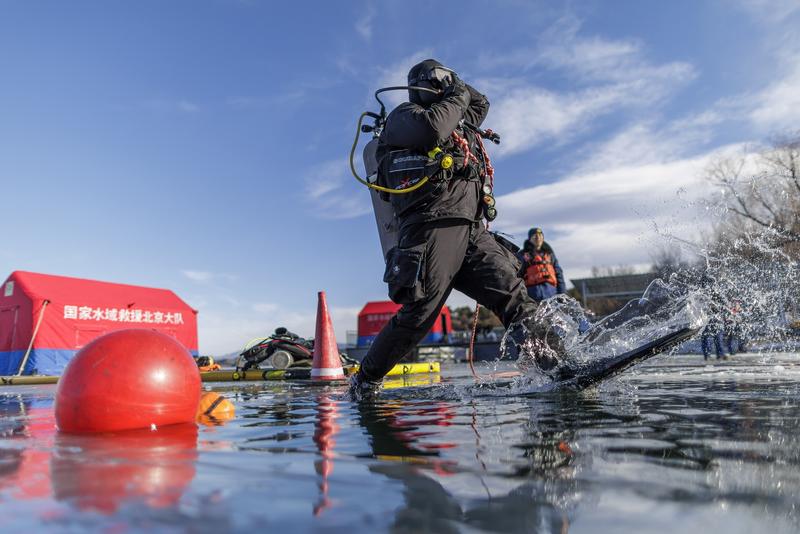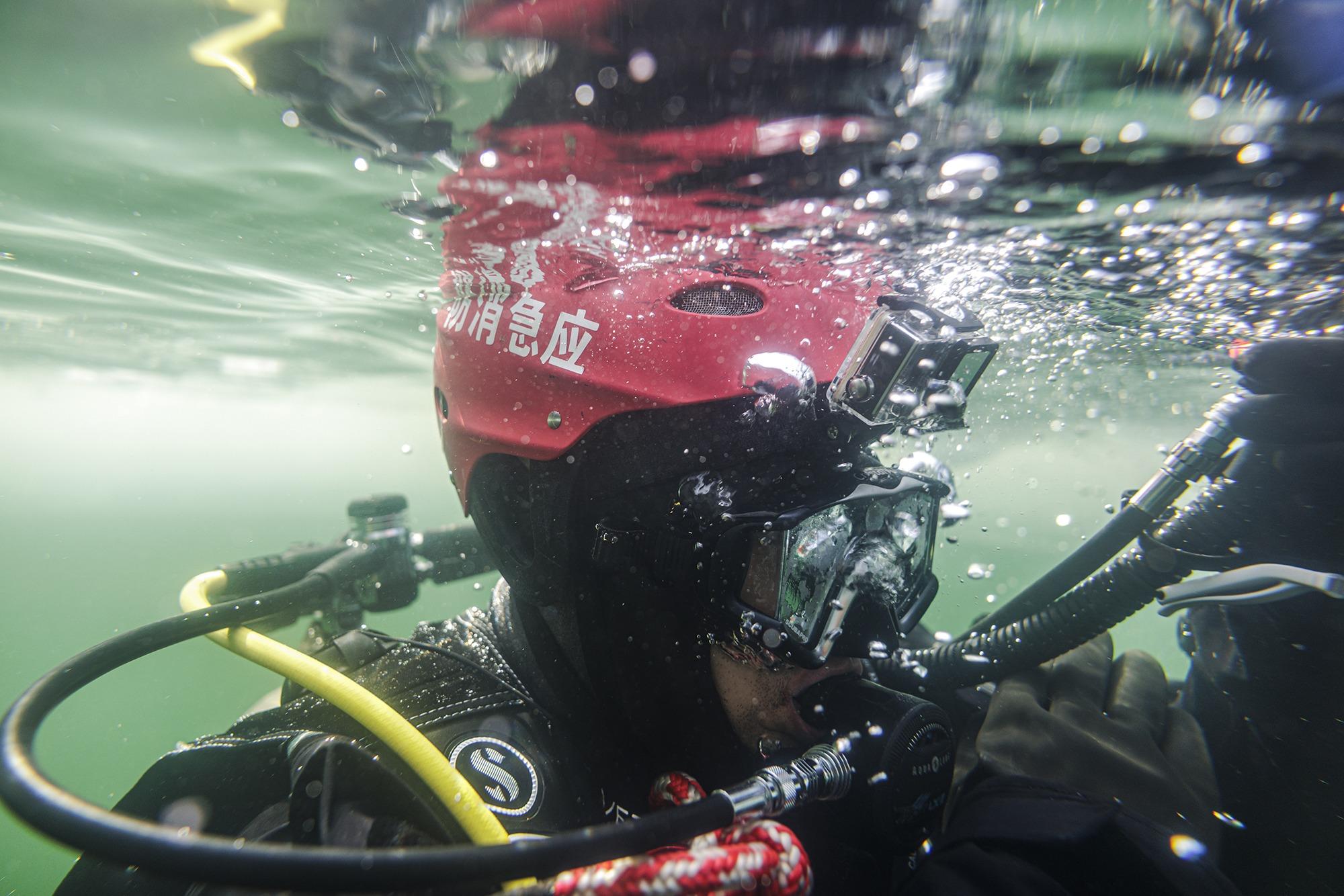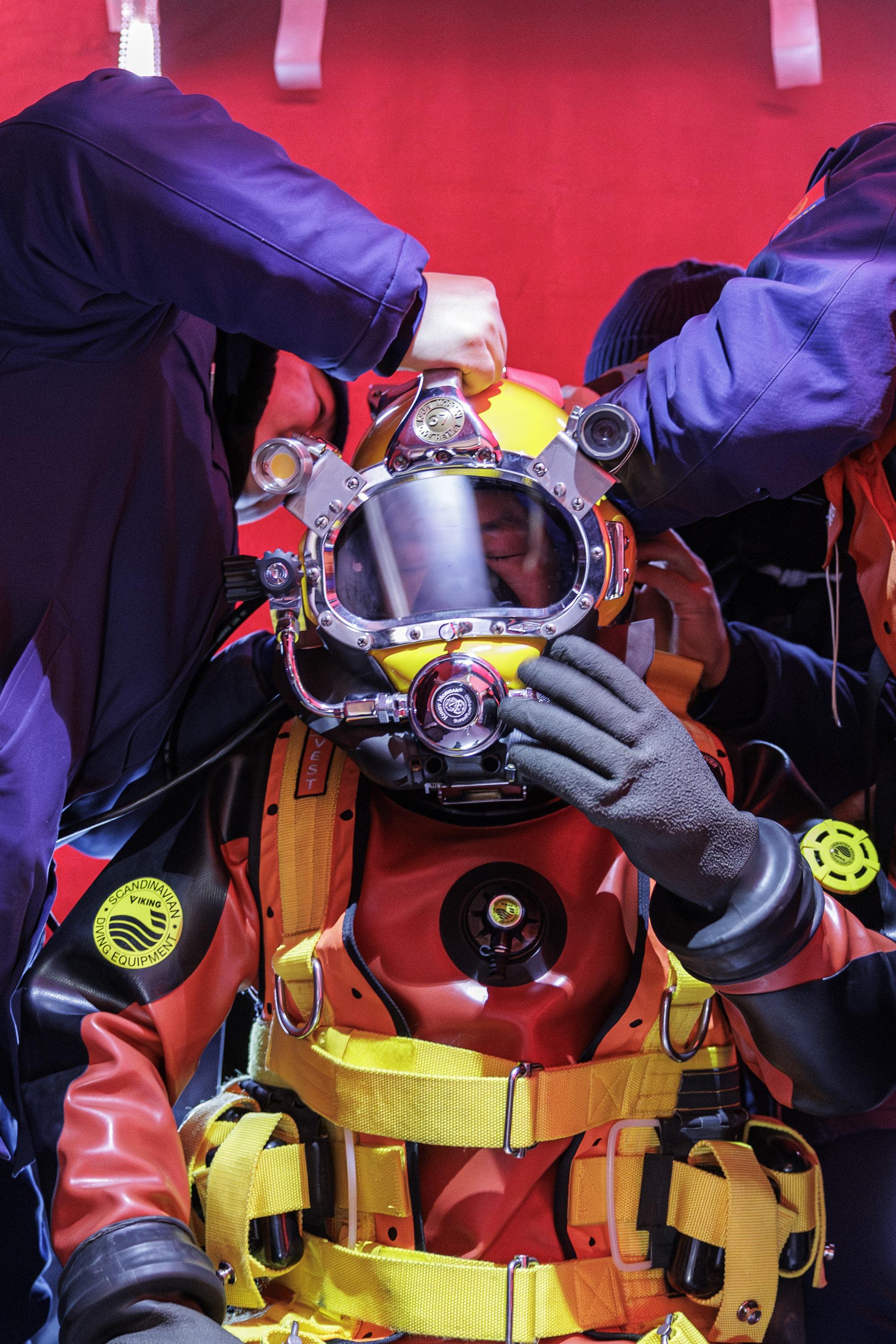Beijing’s water rescue experts risk life in race against time to protect citizens during natural disasters and accidents
 (XING WEI / FOR CHINA DAILY)
(XING WEI / FOR CHINA DAILY)
The temperature gauge registers an unseasonably warm 5 C, yet the frozen expanse of water in northeastern Beijing feels significantly colder.
In the distance, the late January sky is clear and blue and ice fishermen quietly tend to their lines. But the tranquility is soon disrupted by the roar of a chainsaw, which draws a small crowd of curious onlookers who circle a group of firefighters and their equipment.
One of the firefighters cuts a triangular hole in the 20-centimeter-thick sheet of ice and three others emerge from a tent dressed in attire more suitable for another world. They make their way toward the newly opened hole, located no more than 6 meters from the shore.
The firefighters were undergoing their annual training in ice diving, which usually takes place during the coldest time of the year in Beijing. The training typically includes exercises such as ice-cave traversal and underwater searches.
The firefighters belong to the Miyun Firefighting Water Rescue Team, a professional rescue outfit established in 2012 to meet the growing demand for aquatic rescue operations.
In June 2019, the Ministry of Emergency Management’s Fire and Rescue Administration also established the National Water Rescue Beijing Brigade, to build upon the foundations put down by the Miyun team.
In China, there are now eight water rescue brigades similar to the one in Miyun district, which comprise hundreds of firefighters with expertise in such rescues. In recent years, they have participated in various operations during natural disasters including the 2021 Henan floods and the 2023 Beijing deluge.
The teams have largely remained out of the spotlight, and few people are aware of the dangers involved in the rescuers’ work.
 The 20-centimeter-thick ice layer on the day of the firefighters’ training. (WANG ZICHENG / FOR CHINA DAILY)
The 20-centimeter-thick ice layer on the day of the firefighters’ training. (WANG ZICHENG / FOR CHINA DAILY)
In northern China, the toughest rescues occur in winter. A person waiting to be rescued in the South China Sea can survive for around 30 hours, but during the depths of a northern winter, they may lose consciousness in just 20 minutes.
“Our mission is to rescue people trapped in the water, but in most cases, their vital signs are absent when we find them,” said Zheng Haiyang, a 26-year-old firefighter from Dezhou, Shandong province, who has trained as a water rescuer with the Miyun team for about eight years. The reality of ice-diving rescues is often recovering a body trapped under the ice and taking it back to loved ones, he added.
Every winter, there are about five incidents in Beijing requiring ice-diving rescues.
“We can’t use our common sense to understand why people fall through the ice,” said Zheng. “On some occasions, people in danger of drowning after falling into the water may have simply wanted to take a shortcut across an ice surface or to retrieve some items from where they were ice fishing.”
The team of 16 firefighters is always in a race against time and has implemented a 24-hour on-call system.
“The time window for such rescue operations is limited,” said Zheng. “From receiving the alarm to dispatching our firefighting team to the rescue site, at least 15 minutes are required. A person cannot endure that long in the frigid waters of Beijing.”
In 2012, a practical diving skills training program was introduced to enhance the professional skills of the team’s firefighters. The Beijing Municipal Public Security Fire Corps, which became the Beijing Fire Rescue Corps in 2018 as part of a reshuffle, also supplied high-quality equipment to the diving firefighters.
 A firefighter enters the water at the ice-diving training site in Miyun, Beijing, in January 2024. (WANG ZICHENG / FOR CHINA DAILY)
A firefighter enters the water at the ice-diving training site in Miyun, Beijing, in January 2024. (WANG ZICHENG / FOR CHINA DAILY)
Ice-diving rescue operations require up to five people working together to ensure safe procedures. A pair of divers is supported by two safety buddies on the ice as well as an emergency backup diver. A large tent is also pitched near the ice hole to keep the divers warm after they leave the water.
Zhao Qiang, the rescue team’s deputy head and chief diving instructor, said the ice hole is triangular as the shape makes it easier for the divers to exit the water.
“However, it is still a challenging task, and the divers require assistance from their safety buddies to navigate the slippery ice surrounding the hole,” he said.
Zhao said ice diving is more dangerous than free diving in the sea, but it can be a safe operation if procedures are properly followed.
The primary danger in ice diving is the submerged diver not being able to locate the exit hole.
“In the summer, we divers can naturally surface from any water body,” Zhao explained. “However, during the cold of winter, if we get lost under the ice or the tank runs out of compressed air, the situation becomes perilous due to the enclosed nature of the space under the ice. The only escape from such danger is to find the triangular ice hole.”
Hypothermia — long exposure to cold that causes body temperature to dangerously drop — is another major threat to ice divers. However, this risk has been greatly reduced thanks to the use of dry diving suits.
Zhao said that unlike wet suits, which allow water to enter and be trapped and heated by the body’s temperature, a dry suit prevents any water from getting in. Compressed air is pumped into the suit to create a thin layer of air that insulates the diver from the cold.
Zhao said that he recommends to the divers they also wear cotton clothing under their suits to stay warmer. “Otherwise, if the divers don’t wear thermal clothing, the cold will reach their bodies more quickly,” he said.
 A firefighter undergoes ice-diving training in Miyun district, Beijing, in January 2024. (WANG ZICHENG / FOR CHINA DAILY)
A firefighter undergoes ice-diving training in Miyun district, Beijing, in January 2024. (WANG ZICHENG / FOR CHINA DAILY)
Before the divers enter the icy water, the chief instructor usually conducts a final check of all the diving equipment. He inspects the guide ropes for the divers and notes down all the pre-dive checks. Once these operations are completed, the divers can go under the ice.
Two divers in diving suits loaded with equipment then move to the ice hole and with the help of two of their teammates slide into the water. After inserting their mouthpieces, the divers then slowly submerge beneath the icy surface.
“The visibility of the water in winter is the best of all the seasons,” said Zhao. “The activities of microorganisms, algae, and fish in cold water are not that frequent,” he said, adding there is also less plankton, which means the water is not as muddy.
“In addition, beneath the ice ceiling the sunlight filters down and is gently diffused to bathe the scene in a soft and even glow of light,” he said.
Han Hongliang, a 29-year-old senior diver from Suqian, Jiangsu province, was responsible for ice safety during this year’s ice-diving training session in northeastern Beijing. He said that a drag signal made via a yellow hemp rope is the most important “language” used by ice divers in deep water.
“For instance, when I pull the rope slightly, I’m signaling to the diver to check if everything is OK underwater. When the diver tugs the rope in response, I understand that everything is going well beneath the ice,” he said.
“However, if the diver continuously shakes the rope, it indicates that there may be an underwater emergency. This suggests that the diver is experiencing difficulties or facing an emergency from which they cannot easily escape.”
 A member of the Miyun Firefighting Water Rescue Team wears a heavy diving outfit. (WANG ZICHENG / FOR CHINA DAILY)
A member of the Miyun Firefighting Water Rescue Team wears a heavy diving outfit. (WANG ZICHENG / FOR CHINA DAILY)
Part of the divers’ training involves each team member becoming aware of their responsibilities, Han said.
“When two of our teammates are diving, they are each secured by a yellow hemp rope to their signal buddies on the ice’s surface, who manage the line. The third diver serves as a standby diver, fully suited up and ready to intervene at any sign of trouble from below.”
This simple yet effective system of rope signals has become a vital means of communication between the divers and their colleagues on the ice.
Zhao, the chief diving instructor, said the duration of each ice-diving training session is meticulously calculated to ensure the safety and health of every diver.
“Generally speaking, underwater operations typically last about 20 minutes,” said Zhao. “If a diver has not resurfaced after this time under the ice, the signal firefighter will use rope tugs to inquire about the diver’s physical condition, sending him a signal and asking if he feels all right underwater.
“The diver can pull back on the rope to indicate that he is fine,” he said. “But only the diver himself truly knows what is exactly taking place underwater.”
All diving equipment must be treated with antifreeze to ensure it works in icy water.
“Unexpected things happen during ice diving,” Zhao said. “Your air supply might be cut off due to your regulator freezing in the cold water, or you could get the shivers, or you might become entangled in a large fishing net and struggle to free yourself.
“In our training process, we simulate all possible extreme conditions that come to mind, ensuring that our firefighters will not panic when they dive to save people in real situations and have ways to deal with the complications.”
 A diver surfaces from the icy water after training in late January 2024. (WANG ZICHENG / FOR CHINA DAILY)
A diver surfaces from the icy water after training in late January 2024. (WANG ZICHENG / FOR CHINA DAILY)
During this year’s training session, Lu Bingxin, 25, from Tai’an, Shandong, in addition to carrying a 15-kilogram air tank, was weighted down with 12 kgs of lead to help offset the buoyancy of his suit.
He was teamed with diver Hu Yazhuo, 29, from Shenyang, Liaoning province.
Despite all the meticulous preparation, engaging in a diving rescue operation for the first time is far different from the training process.
Han clearly remembers his first rescue operation when he had to dive 18 meters to rescue someone.
“I was very scared the first time I went into the water for a mission. Though my former instructor was diving with me, I couldn’t stop clenching my fists and gripping the rope,” he said.
Thankfully, his instructor helped him to relax. “Suddenly I calmed down and began to swim slowly in search of the person needing rescue,” Han recalled.
Despite the complexity and variability of the underwater environment, and the need to master techniques related to scuba and ice diving, Zhao said saving lives is the top priority on every mission.
“Many Chinese people believe in the importance of seeing a loved one again, regardless of whether they are alive or dead,” said Zhao. “In every rescue mission, our utmost effort is to provide answers to the families of the victims, and that’s what we strive to achieve.”


